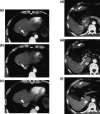Phase I study of sorafenib in Japanese patients with hepatocellular carcinoma
- PMID: 17953709
- PMCID: PMC11158187
- DOI: 10.1111/j.1349-7006.2007.00648.x
Phase I study of sorafenib in Japanese patients with hepatocellular carcinoma
Abstract
Sorafenib is an orally active multikinase inhibitor that targets serine and threonine, and tyrosine kinases that are involved in tumor-cell signal transduction and tumor angiogenesis. This phase I trial was conducted to evaluate the pharmacokinetics (PK), safety, and preliminary efficacy of sorafenib in Japanese patients with hepatocellular carcinoma (HCC) with underlying liver dysfunction. Patients with unresectable HCC, Child-Pugh status A or B, and adequate organ functions were treated. A single dose of sorafenib was administered, followed by a 7-day wash-out period, after which patients received either sorafenib 200 mg (cohort 1) or 400 mg (cohort 2) twice daily. The PK were investigated after a single dose and during steady state. The efficacy was evaluated using the Response Evaluation Criteria in Solid Tumors. A total of 27 patients were evaluated for PK, safety, and efficacy. Although both area under the concentration-time curve for 0-12 h and maximal concentration at steady state were slightly lower in Child-Pugh B patients than in Child-Pugh A patients, the difference was not considered to be clinically relevant. Common adverse drug events included elevated lipase, amylase, rash or desquamation, diarrhea, and hand-foot skin reaction. A dose-limiting toxicity of hand-foot skin reaction was observed in one patient (cohort 2). Among the 24 patients evaluable for tumor response, one patient (4%) achieved a partial response, 20 (83%) had stable disease, and three (13%) had progressive disease. Sorafenib demonstrated a favorable tolerability and safety profile in Japanese HCC patients. Moreover, promising preliminary antitumor activity has been observed. Finally, there were no clinically relevant differences in PK between Child-Pugh A and B patients.
Figures


References
-
- Ryu M, Shimamura Y, Kinoshita T et al . Therapeutic results of resection, transcatheter arterial embolization and percutaneous transhepatic ethanol injection in 3225 patients with hepatocellular carcinoma: a retrospective multicenter study. Jpn J Clin Oncol 1997; 27: 251–7. - PubMed
-
- Okuda K, Mitchell DG, Itai Y et al . Hepatobiliary disease. Primary Malignant Tumors of the Liver. London: Blackwell Science, 2001: 343–89.
-
- Bruix J, Sherman M, Llovet JM et al . Clinical management of hepatocellular carcinoma. Conclusions of the Barcelona‐2000 EASL conference. European Association for the Study of the Liver. J Hepatol 2001; 35: 421–30. - PubMed
-
- Llovet JM, Real MI, Montana X et al . Arterial embolisation or chemoembolisation versus symptomatic treatment in patients with unresectable hepatocellular carcinoma: a randomised controlled trial. Lancet 2002; 18: 1734–9. - PubMed
-
- Takayasu K, Arii S, Ikai I et al . Prospective cohort study of transarterial chemoembolization for unresectable hepatocellular carcinoma in 8510 patients. Gastroenterology 2006; 131: 461–9. - PubMed
Publication types
MeSH terms
Substances
LinkOut - more resources
Full Text Sources
Other Literature Sources
Medical

